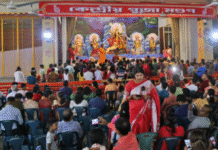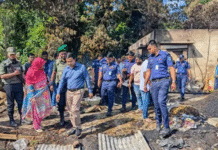
The Asia Foundation recently hosted U.S. Ambassador to Bangladesh, Dan W. Mozena, for an informal lunch discussion at its San Francisco headquarters, followed by a public eventorganized by the Foundation’s Washington, D.C., office. While in San Francisco, In Asia editor Alma Freeman sat down with Ambassador Mozena to discuss Bangladesh’s goals to become a middle-income country, its need for an “education revolution,” the role Bangladeshi-Americans in the Silicon Valley can play in development, and why Bangladesh – the nexus of inter-regional trade – is an emerging “Asian Tiger.”
Bangladesh has made tremendous strides over the last decades, and the government has announced that it aims to become a middle-income country by 2021. What are your thoughts on the progress toward that goal?
2021 might be a little soon – that’s the 50th anniversary of the founding of the country. It might be possible, but it takes decisions made now for Bangladesh to become a middle-income country. First – a middle income country has very real meaning – it’s a country where families have the means to provide a safe, secure home for their family. It means a family can procure ample and nutritious food so children are healthy and not stunted; it means a family has access to quality health care and good education. A middle-income Bangladesh is not an abstract concept, it’s real, and I think that it’s very much achievable.
Bangladesh has taken a number of steps toward achieving that goal, which I roll together when I call the country the next “Asian Tiger.” Goldman Sachs talks about the emerging 11 countries, including Bangladesh. JP Morgan talks about Frontier 5, including Bangladesh. A McKinsey report said Bangladesh could be the world’s largest exporter of ready-made garments and household textiles. Bangladesh has the potential to become a big player in generic pharmaceuticals, building small and medium freighters, building tugboats, footwear, finished leather products, flowers, silk, frozen shrimp. Combine that with the ongoing agricultural revolution that is happening this very minute where you will have a Bangladesh that is already rice surplus. Bangladesh is the nexus of inter-regional trade, right in the middle of the Indo-Pacific economic corridor.
What challenges could get in the way?
Bangladesh needs to have an education revolution, and this is where it comes up short. If you are going to have 200 million people, which is what Bangladesh is going to have by the year 2050, you need to export skilled manpower. But right now, Bangladesh exports 8.5 million largely unskilled workers. Why not export doctors, nurses, carpenters, and plumbers? There are other constraints that should not be diminished. The port is deficient. The road network needs to be improved – the road from Dhaka to Chittagong, the second largest city, is fully deficient. The railroad carries only 80,000 containers a year. Power shortages are a self-inflicted constraint. I recently visited the largest fertilizer manufacturing company in Bangladesh. The day I was there was day 59 that that company had no gas. No gas means they produce zero, with a full work force doing absolutely nothing. Corruption eats the country alive – 1.5-2 percent of growth is lost due to corruption. Political instability is rising. These are all serious, real constraints, and are all resolvable.
Shahbag Intersection in the heart of Dhaka, Bangladesh, was recently jolted by protestors, the majority of whom were young college students, including many women. What does this say about Bangladesh’s youth?
Eighty percent of Bangladesh is under 40 years old, 65 percent is under 25. Bangladesh has coming soon what’s called the demographic dividend. Right now you have coming into the productivity years this massive bulge of young people who, if properly employed, will generate massive amounts of economic activity. Of course if they have no job opportunities, or are underemployed, they can become a threat to stability. That’s a real potent force for economic development in Bangladesh. I spend a lot of time with young people through my Ambassador’s Youth Council, and I’m exhilarated with the young people I meet. They are focused on the future, not the past. What you see in Shahbag is an exception to that. I see this event as a manifestation of a democratic right to express your views. I was surprised that it happened. This particular issue sparked something that unleashed this enormous outpouring spontaneously linked to this one issue. Yet to be discerned is whether or not this great passion that has oozed out in the streets is driven by frustrations much broader than this one sentence.
What do you think are the biggest misconceptions that Americans have about Bangladesh and vice versa?
When Bangladesh makes the news in the U.S., it’s almost always a negative story, like violence in the streets or the Tazreen Fashion factory fire in November. From that, related negative stories about labor rights and working conditions are extracted. I’m not saying those aren’t true, but those are the only stories that play. The positive stories about how Bangladesh is an emerging Asian Tiger, about how this country, against all odds, is going some place fast, about the optimism of the country. These stories don’t make American news so Americans lack an understanding of these dimensions of Bangladesh.
Bangladeshis know about America. A recent poll said 76 percent of Bangladeshis have a positive image of the U.S. But their misconception is that America can somehow wave a magic wand and solve problems. I am constantly asked with full sincerity when I am going to solve the political impasse. And they mean that literally. But these are Bangladesh’s problems, and they are going to be solved by Bangladesh. America, like Bangladesh’s other friends, can be helpful as Bangladesh moves to implement these solutions.
BRAC, the world’s largest NGO, was founded by Bangladeshi Sir Fazle Hasan Abed (who was also an Asia Foundation Chang-Lin Tien Distinguished Visiting Fellow in 2012). What role has civil society played in Bangladesh?
Civil society is a huge driving force in Bangladesh’s development. It’s interesting to think that in the U.S., the best and the brightest often go into business. In India, traditionally the best and brightest would go into civil service, in Bangladesh, the best and the brightest form NGOs. Young people create huge NGOs. BRAC is the largest NGO in the world, and I see it in action in villages all over. Grameen is a huge NGO helping mainly women help themselves, and so many more NGOs are up and running helping to build the country. The effectiveness of these NGOs has contributed enormously to the country’s continuing growth, averaging over 6 percent over the last 20 years – how many countries can say that?
During your visit to San Francisco, you met with a number of Bangladeshi-Americans in the Silicon Valley. What did you take away from these discussions?
I think Bangladeshi-Americans here in Silicon Valley can play a major role in making Bangladesh more prosperous. And, a prosperous Bangladesh is very much in the interest of the United States. We are currently working on a philanthropy portal – a mechanism by which Bangladeshi-Americans who want to donate money back to Bangladesh can do so in a way that they can track how their money is spent, and with confidence of where it ends up. We are also creating an ideas marketplace to help entrepreneurs here link up to people with new fresh ideas in Bangladesh. I think that especially in Silicon Valley, there are a lot of resources, and creative energy oozes out of every pore. All of these things are here in a big way, and when linked up to Bangladeshi spirit and entrepreneurship, I think Bangladesh could be the next Bangalore. Why not?
Source: Asia Foundation









